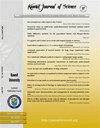科威特 Al-Batin 旱谷的环境地貌:揭示自然和人为影响因素
IF 1.2
4区 综合性期刊
Q3 MULTIDISCIPLINARY SCIENCES
引用次数: 0
摘要
Wadi Al-Batin 是一个古老的山谷,是伊拉克和科威特之间的天然边界,也是沙特阿拉伯较大的 Wadi Al-Rummah 盆地的一部分。自 20 世纪 80 年代以来,军事区、油田和营地等人类活动使该地区的地质、地貌和水文条件发生了重大环境变化。本研究调查了 Wadi Al-Batin 地貌、沉积学和地形的变化,以及人工地貌和自然因素造成的土地退化和环境变化,并对 Wadi Al-Batin 的沉积学地图进行了更新。这项研究利用实地观测、地理信息系统(GIS)和遥感技术(RS)开发了一个跨学科的地理数据库。利用 2000 年至 2023 年的卫星图像绘制了 Wadi Al-Batin 环境地貌变化的详细地图,以提供最新的精确信息。研究还将归一化差异植被指数(NDVI)和归一化差异水指数(NDWI)的变化作为环境变化的指标。结果表明,地表沉积物呈现多模式和三模式(分别占 40% 和 36%),为砂质和中粗粒,在排序、偏斜度和峰度方面表现出变异性。它们源于 Dibdibah 地层的上统,经常被冲刷再加工,主要由石英组成,方解石含量较低。这项研究有助于保护环境系统,协助决策者保护后代享有可持续环境的权利。本文章由计算机程序翻译,如有差异,请以英文原文为准。
Environmental geomorphology of Wadi Al-Batin, Kuwait: Unveiling natural and anthropogenic influences
Wadi Al-Batin is an ancient valley that acts as the natural boundary between Iraq and Kuwait and is part of the larger Wadi Al-Rummah Basin in Saudi Arabia. Since the 1980s, human activities like military zones, oil fields, and camps have caused significant environmental changes in the area's geological, geomorphological, and hydrological conditions. This study investigates changes in the geomorphology, sedimentology, and topography of Wadi Al-Batin, land degradation and environmental changes caused by artificial landforms and natural factors and provides an update to the sedimentological map of Wadi Al-Batin. The study utilized field observations, geographical information systems (GIS), and remote sensing (RS) techniques to develop a geodatabase across various disciplines. A detailed map of the environmental geomorphological changes in Wadi Al-Batin was created using satellite imagery from 2000 to 2023 to provide up-to-date and precise information. The study also considered changes in the normalized difference vegetation index (NDVI) and normalized difference water index (NDWI) as indicators of environmental change. The results indicate that the surface deposits exhibited polymodal and trimodal modes (40% and 36%, respectively), were sandy and medium-coarse-grained, and showed variability in sorting, skewness, and kurtosis. They originated from the Upper Member of the Dibdibah Formation, were frequently fluvially reworked, and predominantly consisted of quartz with lower amounts of calcite. This study contributes to the preservation of environmental systems and assists decision-makers in protecting the rights of future generations to a sustainable environment.
求助全文
通过发布文献求助,成功后即可免费获取论文全文。
去求助
来源期刊

Kuwait Journal of Science
MULTIDISCIPLINARY SCIENCES-
CiteScore
1.60
自引率
28.60%
发文量
132
期刊介绍:
Kuwait Journal of Science (KJS) is indexed and abstracted by major publishing houses such as Chemical Abstract, Science Citation Index, Current contents, Mathematics Abstract, Micribiological Abstracts etc. KJS publishes peer-review articles in various fields of Science including Mathematics, Computer Science, Physics, Statistics, Biology, Chemistry and Earth & Environmental Sciences. In addition, it also aims to bring the results of scientific research carried out under a variety of intellectual traditions and organizations to the attention of specialized scholarly readership. As such, the publisher expects the submission of original manuscripts which contain analysis and solutions about important theoretical, empirical and normative issues.
 求助内容:
求助内容: 应助结果提醒方式:
应助结果提醒方式:


